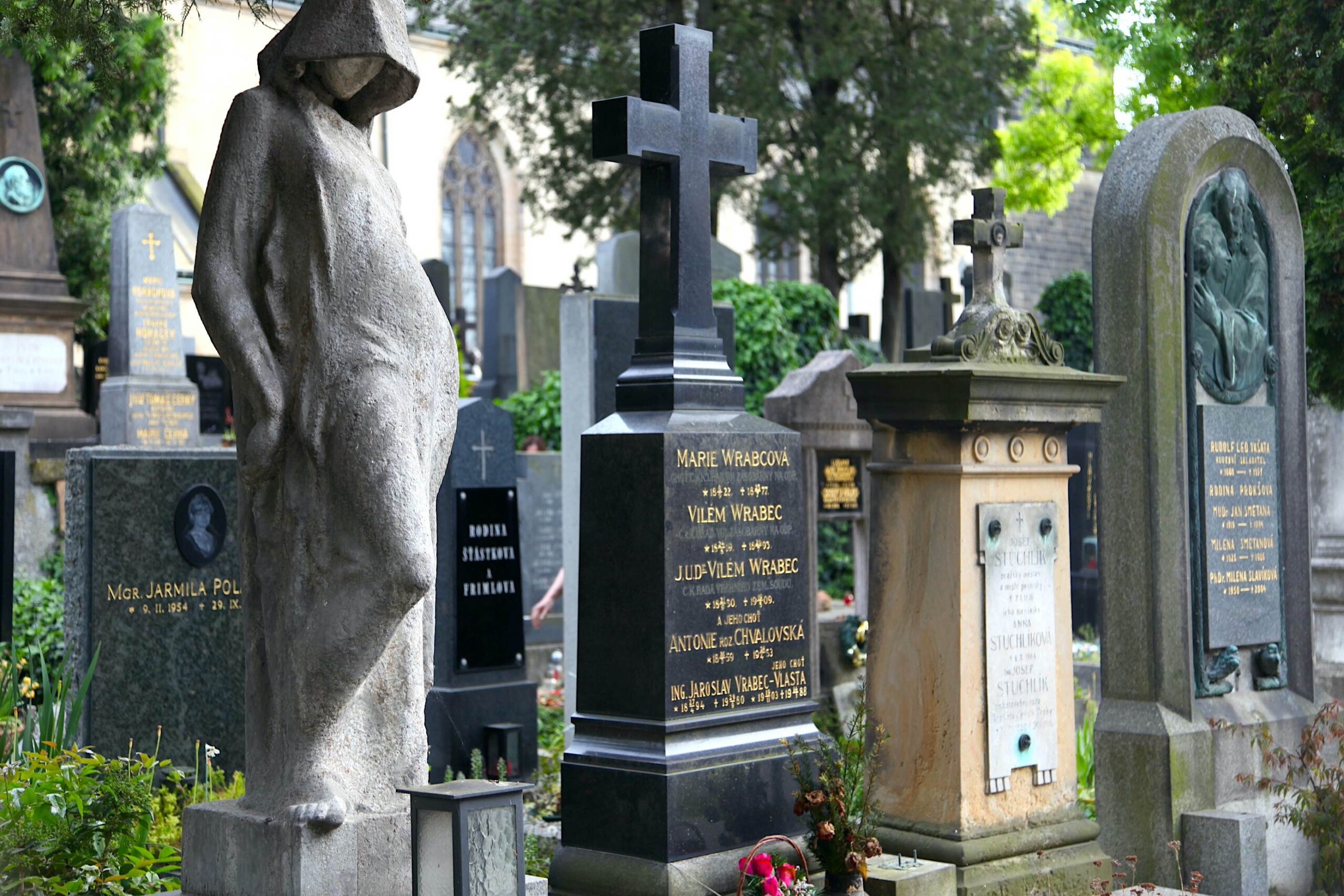目次
・ Introduction
Sculptures, statues and objects are everywhere in public spaces in Europe – in parks, building yards and even cemeteries. How do you feel and what do you think about these artworks, which may or may not bother you? Perhaps the answer is often “I don’t know” how to feel or even what to look at. In response to these expectations, Art Survive Blog, a professional sculptor, will introduce you to a group of sculptures standing in a cemetery. We hope that through this, we can provide you with a basic view and a primer on how to enjoy the sculptures in your future encounters with them.
This article is a collaboration with FUNART, run by the company TOMBOW Pencil. The article is about Vyšehrad, a folk cemetery in Prague, Czech Republic, and is about the fascination of typography.

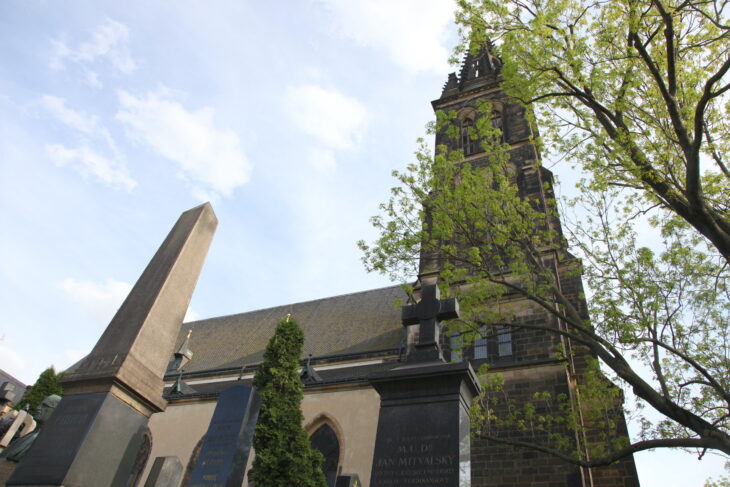
・ National cemeteries in Vyšehrad
Vyšehrad in Prague, Czech Republic, is now a scenic park with a church, a folk cemetery and a view from the ruins of the castle. Within the ruins of the castle, the church and cemetery offer a quiet and atmospheric experience.
The folk cemetery in Vyšehrad is also known as the ‘artists’ cemetery’, a rarity in Europe, where the entire cemetery is decorated with unique sculptures and decorations. The environment is open to all during opening hours and is a well-known for tourists. Of course, it is a cemetery and should be enjoyed in a respectful and quiet manner so as not to be rude.
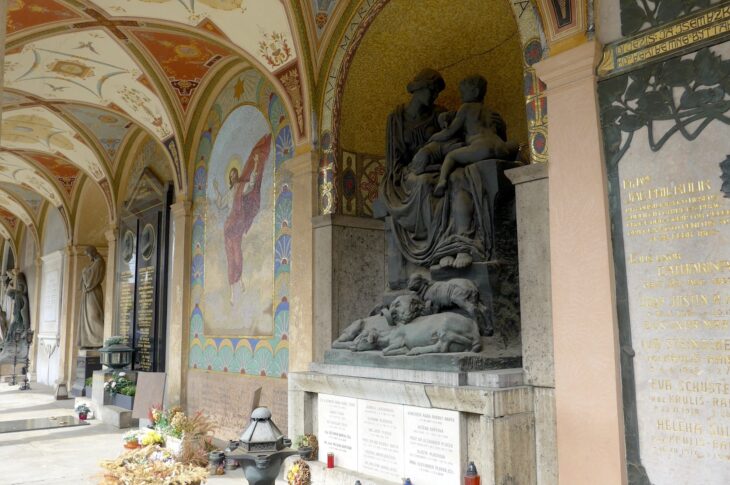
・Artists and sculptures
This national cemetery was created in the second half of the 19th century as a burial place for those who had made a contribution to the Czech nation and many of the country’s most famous artists were buried here. The main attraction of the cemetery is the very unique graves of the artists. This grave groups, each individual grave is colourful with flowers and decorations. This ethnic cemetery in particular is lined with objects and sculptures related to the artist. The works and monuments of the deceased artists are displayed, as well as the decorations and epitaphs, all of which are original in every detail and could be described as a sumptuous exhibition.

・Types of sculptures
Let’s now take a look at the different sculpture divisions and types through the diverse sculptures in Vyšehrad cemetery. In doing so, we will be referring to sculptures, objects and monuments in general, which vary in their scope of capture depending on the time period and type of industry. Therefore, I will skip the definition part for the present article, and will instead show the different types of ‘sculpture’ and the way the word is used. In reality, sculpture cannot be roughly divided in this way, but rather is made up of multiple genres and layers of history, overlapping each other like a gradation. However, by colour-coding them this time, I dare to say that it will be easier to visualise the whole picture, albeit superficially.
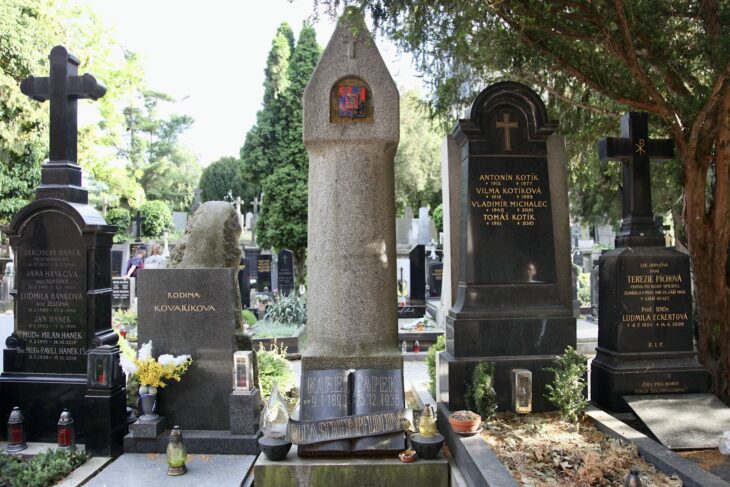
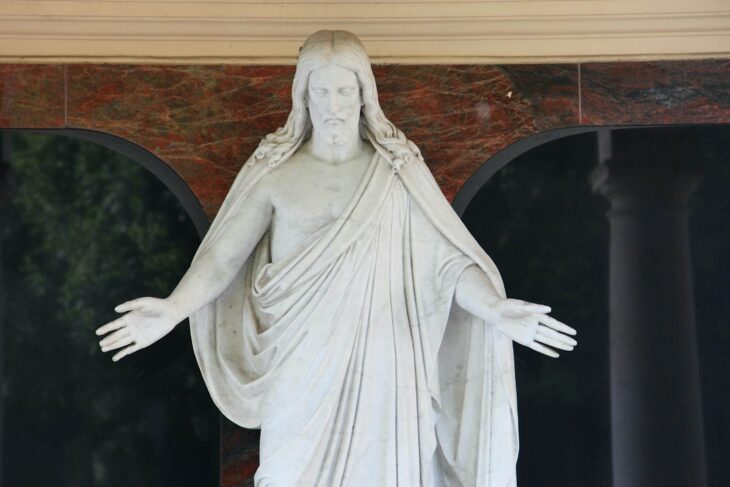

1: Sculpture = ‘Engravsing’, where the text is carved into the stone as a headstone
Unlike writing with ink, engraving a headstone by carving words into the stone is considered “engraving”. The words “write”, “draw” and “paint” are all said to derive from the word “scratch”. In the days when there were no pens or paper, people scratched records on stones and wood, indicating that “the act of engraving preceded the act of painting” and the primitive nature of engraving. The term sculpture is used for the act of ‘carving, engraving and marking signatures’ itself.”

2: “Sculpture” as “craft” and “decoration”
” Craft” means crafts and folk art, and is associated with “things that have a daily use”. Decoration” is not a stand-alone value, but an aesthetic element that adds value to the subject or purpose.
The granite that forms the fulcrum of the metal fence on the top left of the photo is a wonderful work of art, with its overall balance, the volume of the stone, the surface and edges of the stone.
The “mosaic sculpture” decoration at the entrance to the church, shown in the bottom right of the photo, is a fascinating example of coloured art combining the serpent of the god and the serpent of the goddess.
Related with this article,
>Art of Central and Eastern Europe

3: ‘Sculptures’ of religious art
Not only Christian art, but also “sculptural works” are imbued with the presence of the gods. The objects (motifs) created were basically characters from legendary stories, such as angels and pietas, and in times of low literacy, these sculptures and oral traditions were used to convey the presence and status of the gods.

4: ‘Portrait sculpture’
Western sculpture has preserved important figures such as the saints mentioned earlier in the form. It later became not only saints, but also portraits of important aristocratic and famous people, and portrait sculptures were created to symbolise their reflections. Below right in the picture is the tomb of Antonin Dvorak, for which a bronze statue of him was made. The two statues in the top right of the photo are probably a couple. The shade of the wife is interesting. The upper left photo was carved out of marble and is reminiscent of medieval Italian sculpture.
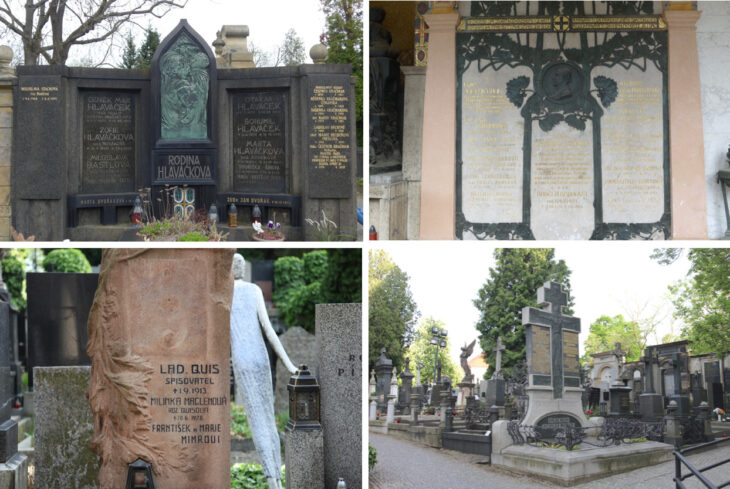
5: ‘Relief sculpture’
There are many artists who specialise in “relief engraving”. This is a very profound genre of work that gives a three-dimensional appearance to surfaces of a few millimetres to a few centimetres, such as the surface of a numismatic coin or a wall.

6: ‘Human sculpture, human figures’
The act of sculpting can be broadly divided into the act of reducing the mass of a material by shaving it down = ‘carving’, but also the act of adding clay or other materials to create a sculpture = ‘modelling’. The upper left photo shows a bronze casting from viscosity modelling, and the upper right photo shows a sandstone carving sculpture. The sculptor in the top right photo, František Bílek (1872 – 1941), was an artist who mainly carved wood, and the soft, well-known Czech sandstone carvings show a “woodcarver’s way” of carving. Even the carvings are unique. However, the forms and expressions that can be achieved naturally vary depending on the processing method and materials used.

7: ‘Figurative sculpture’
The genre of ‘figurative sculpture’, which overlaps in scope with the human body sculpture described above, is considered to be figurative sculpture if the motif (object) is ‘realistically depicted and concrete’, whether it is a human part, an animal or a plant.

8: ‘Abstract sculpture’
Abstract sculpture is contrasted with figurative sculpture. Abstract sculpture is literally “abstract”, meaning that the essence of a motif or concept is extracted and deformed. Generally speaking, most of the “unintelligible” types of art may be classified as abstract art. Abstract forms are also influenced by trends of the time, with the top left photo showing strong elements of cubism, which became popular from the early 20th century, as figurative art and decorative sculpture reached a certain zenith at the end of the 19th century, or as a reaction to this, when there was a demand for simplification of concepts and forms.
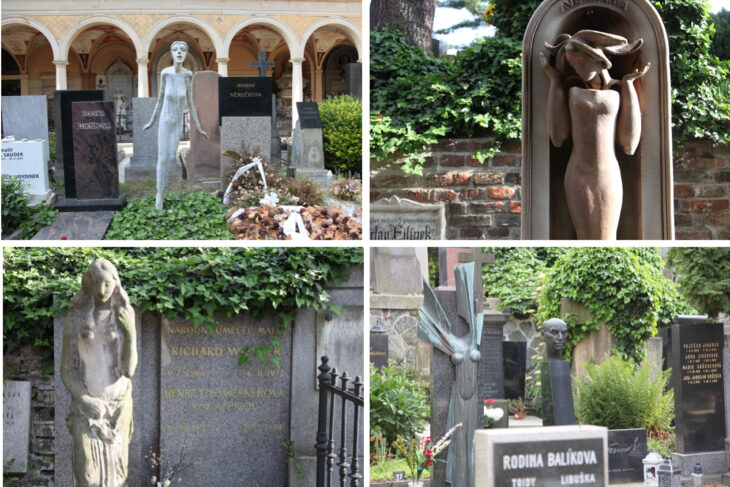
9: ‘Modern sculpture’
Modern sculpture is not a lineage of sculpture, but a general term for forms and ideas that were popular in the of 20th century. The Czech sculptor Olbram Zoubek (1926 – 2017), who created the top left photo, was influenced by Alberto Giacometti (1901 – 1966), whose work evokes images of negativity and death. Giacometti 1901 – 1966). There, the sculptor Zoubek expresses the most common idea of Eastern Europe, “the influence from communism”.

10: “Contemporary sculpture”
In Japan, the term ‘contemporary sculpture’ is used to describe works produced from 1960 onwards, while ‘conceptual art’, which began around that time, is often referred to as ‘contemporary art’. Marcel Duchamp at the beginning of the 20th century is often regarded as the father of contemporary art. Unfortunately, the cemetery has a long history, and there are few objects that have been created recently. Among them, we can infer that the grave on the left of the photo was recently created, given its contemporary minimalist taste and the completely unblemished look of the marble. On the right is a ‘sculptural’ graffiti sculpture by artist Jan Kaláb, a friend of the Art Survive blog.

11: ‘Tombstone-Shop Sculpture’
In the discriminating view of the sculptor, the sculptors refer to their work as “grave maker’s sculptures”, which are “made in the manner of a headstone maker”. They refer to work that “looks cold and machine-made”, or work that “gives the impression of drawings or blueprints” before it is made. However, the difference between the bottom left and right and the top right and left is clearly visible, as is the difference in the skills of the headstone maker’s work from the time when it was made.

・Summary
So far, various sculpture genres have been introduced.
Just as the city of Prague is known as a ‘museum of architecture’ where you can see everything from the Middle Ages to the present day, so you can see that this cemetery has a diverse range of sculpture genres on both the vertical and horizontal axes.
We also found that sculptures created by sculptors with completely different ideas of dimensions can never be viewed in a general way.
We hope that this article will give you a hint on how to look at sculpture and help you to visualise the historical background and story of the artist’s life.

